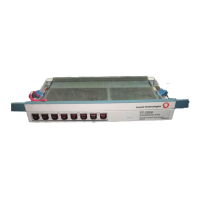Craft Interface Terminal Usage
11-42 Issue 8.0 July 2002
Releases 2 and Later (Use the FAULT category.)
The report above shows that no active alarms or status conditions of the
requested level are reported for the addressed FT-2000 network element.
If a protected (non-service-affecting) failure becomes unprotected
(service-affecting) because of a failure to the protecting circuit
pack or line, then both failures are adjusted accordingly, Similarly,
if an unprotected failure becomes protected, the alarm level of that
failure is adjusted accordingly.
Source
Address
- Shows the address for the condition within the FT-2000 network
element. For Release 2, example 2 shows that an abnormal
condition occurred in the low-speed shelf, line 1, slot 1a, at port 1
(Source Address of ls-1-1a-1). A dash (-) indicates no
particular address for a condition (for example, a protected power
failure). For Release 3, an abnormal condition is shown in the
same but without the line indicator (1 or P). Some conditions give
an address, for example “sts1-1w-6-3”, meaning an incoming sts1
(DS3) signal on line 1w at tributary 6 on port 3 is receiving
“path yellow.”
Date Time
Detected
- Shows the month, day, and time in hours, minutes, and seconds
that the alarm condition was first detected. If an alarm level
changes because of a second failure (higher alarm level), the time
will change to correspond to the second failure.
Srv - Shows when service is affected (SA), or not affected (nsa). SA
could be a DS3 INTFC failure, and an nsa couldbeanAPS
channel failure.
Description - Shows a brief description of the condition. Explanations of these
conditions are provided in Table 9-2 in Volume I, Section 9,
“Maintenance Description.”
Lucent Technologies-FT-2000 96-07-19 23:15:15 EST
M Retrieve-Alarm:All: COMPLD
/* Active Alarms and Status Report
=======================================================================
There are no active alarms or status conditions of the requested level.
*/
;

